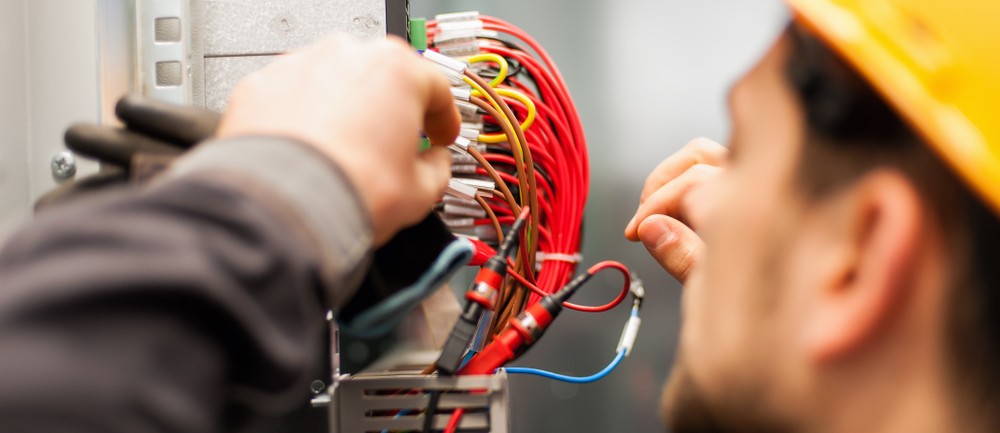Electrical circuits are the backbone of modern technology. They enable the flow of electricity and powering devices.
A circuit is a closed loop through which electric current can flow. Understanding the different types of circuits is essential for anyone working with electrical systems, especially in a commercial building setting.
In this article, we will explore various types of circuits, including open circuits, closed circuits, short circuits, series circuits and parallel circuits, AC circuits, DC circuits, single-phase circuits, and polyphase circuits.
Open Circuit
An open circuit is a type of circuit where there is a break in the path of current flow. It means that the circuit is incomplete, and electricity cannot flow through it. In an open circuit, the electrical contacts are disconnected or interrupted, preventing the current from reaching its intended destination. This could be a switch in the off position or it might come from an error like a component failure or a break in a conductor. This also means that sometimes an open circuit can be dangerous if a cable is accidentally broken.
Closed Circuit
A closed circuit is the opposite of an open circuit. It is a circuit in which the path for current flow is complete, allowing electricity to move freely. In a closed circuit, the electrical contacts are connected, providing a continuous path for the current. When a switch is turned on, it closes the circuit, enabling the flow of electricity and powering the circuit, i.e. when your lightbulb turns on.
Short Circuit
A short circuit occurs when there is an unintended connection between two points of a circuit with low resistance. This connection creates a bypass for the current, allowing it to flow along an unintended path. Short circuits often result in excessive current flow, leading to overheating, damage to components, or even electrical fires. Short circuits are typically caused by an overload of electricity, faulty wiring, improper electrical connections, manufacturing defect, or contact with a lot of water.
Series Vs. Parallel Circuit
There are two fundamental ways in which more than two circuit components are connected: series and parallel.
A series circuit is a circuit configuration in which the components are connected in a single loop, one after another. In a series circuit, the current has only one path to follow, flowing through each component in sequence. The voltage across each component adds up, and the current remains the same throughout the circuit. If one component fails or is removed, the entire circuit opens, and the current ceases to flow.
Conversely, in a parallel circuit, the components are connected in separate branches, providing multiple paths for the current to flow. Each component has its own separate connection to the power source. Unlike a series circuit, the voltage across each component in a parallel circuit is the same, while the current divides among the branches. If one component fails or is removed, the current can still flow through the other branches.
In summary, series circuits have components connected end-to-end, with a single path for current flow, while parallel circuits have components connected across each other, forming multiple branches and paths for current flow. The behavior of voltage, current, and the ability to operate independently are the key distinctions between these two circuit configurations.
Series-Parallel Circuit
A series-parallel circuit is a combination of series and parallel circuits. It consists of both series-connected and parallel-connected components. This configuration allows for more complex circuit designs, accommodating a wide range of applications. By combining series and parallel connections, it is possible to create circuits with specific voltage and current requirements.
AC Circuit
An AC circuit, short for alternating current circuit, is a circuit in which the direction of the current changes periodically. Alternating current is commonly used for the transmission and distribution of electrical power. AC circuits offer several advantages. They facilitate long-distance power transmission with minimal energy loss, as transformers can be used to step-up or step-down voltage levels as needed. They also allow for the efficient use of electric motors, which are essential for operating machinery, appliances, and HVAC systems.
DC Circuit
DC, or direct current circuit, is a circuit in which the current flows in one direction, typically from a DC power source such as a battery or a rectifier. DC circuits offer certain advantages that make them suitable for specific applications. Unlike AC circuits, DC circuits have a constant voltage level. This means that they are commonly used in electronic devices like computers, mobile phones, and portable electronics. These devices require a steady power source that remains unaffected by the direction of current flow. Additionally, DC circuits are suitable for applications involving electronic control systems, such as in automotive electronics, where stable and precise voltage levels are crucial.
Single Phase Circuit
A single-phase circuit is a type of AC circuit that utilizes a single sinusoidal waveform, which is a smooth, repetitive, and symmetrical curve that represents an oscillating or periodic signal. It is commonly used for residential and small-scale applications. Single-phase circuits power most household appliances and lighting systems.
Polyphase Circuit
A polyphase circuit is an AC circuit that consists of multiple phases. It involves the use of two or more sinusoidal waveforms with a specific phase relationship. Polyphase circuits are utilized in industrial and commercial applications, where higher power requirements are necessary. Three-phase circuits are the most common form of polyphase circuits.
In Conclusion
Understanding the various types of circuits is essential for comprehending the principles of electricity and designing electrical systems. Open circuits, closed circuits, short circuits, series circuits, parallel circuits, series-parallel circuits, AC circuits, DC circuits, single-phase circuits, and polyphase circuits each have their unique characteristics and applications.
If you require assistance for your building’s electrical system do not hesitate to reach out to the professionals at Mark Thomas and Associates (MTA). Our team of experts is well-versed in all aspects of electrical circuits and electrical testing and can provide valuable guidance and support for your commercial or industrial building.

